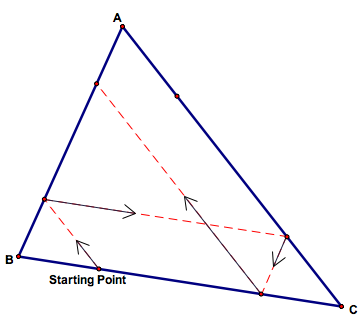
Charlie Conway 7/30/2009
Bouncing Barney
Task: Given any triangle ABC, Barney bounces from one side to another, always bouncing parallel to the opposite side.

Barney continues bouncing like this until he returns to the side he started on.
The question is, does Barney return to his original starting point?
In order to answer this question, we will use the contrapositive. Let us assume that Barney begins his journey at S and ends at E following the directions of the parallel sides that were set out for him.
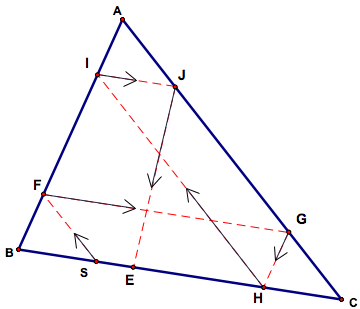
Proof: By construction, we know that SFAJ is a parallelogram. Therefore SF=AJ and FA=JS because opposite sides of a parallelogram have equal length. Also we know that SF is parallel to AJ and FA is parallel to JS because opposite sides of a parallelogram are parallel. But since we also know that JE is parallel to FA, then angle AJE is equal to angle SFA. Since E must be on segment BC, then SFJE is a parallelogram. Thus S and E are concurrent. So Barney does end at the same point he began.
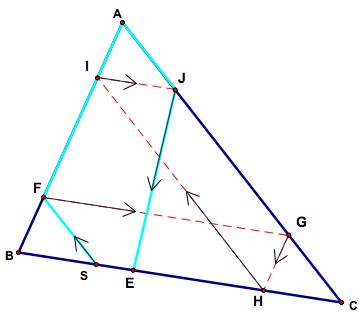
Another topic for discussion is how many times Barney will hit a wall before returning to his starting point. Let us assume that Barney begins at a point not a vertex of triangle ABC. If he did start at a vertex, it seems rather obvious he would simply follow the sides of the triangle.
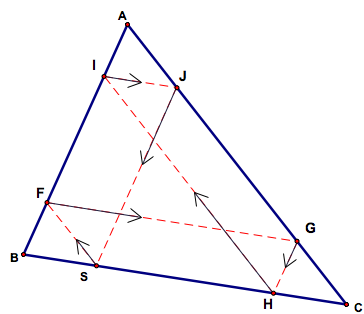
As you can see, Barney hits each wall twice before finally ending up at his starting point. This leads to six total wall hits. This is the case in all but one point. We will prove that this point is the midpoint of a side of triangle ABC.
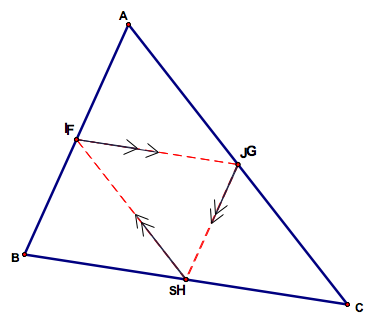
Now it seems that by beginning at this particular point, points I and F have become concurrent, points J and G have become concurrent, and points S and H have become concurrent. Normally Barney would only return to his starting point on the second time he reached the side he began on (in this case, BC). However, it appears that in this case, the first time Barney returns to BC, he is back to the starting point.
Proof: By construction, IJ is parallel to BC and JS is parallel to AB. Therefore, since opposite sides of a quadrilateral are parallel, BIJS is a parallelogram. Then it follows that BS=IJ and BI=SJ because opposite sides of a parallelogram have equal length. The same argument can be made to show that SC=IJ and SI=CJ. Since BS=IJ=SC, then BS=SC, so S must be the midpoint of BC.
Now to show that H is concurrent with S. Barney begins at S and his first move is parallel to AC until he hits AB. Since he begins at the midpoint of BC and runs parallel to AC, then it follows from the midsegment theorem that F is the midpoint of AB. He then travels parallel to BC until he reaches AC. Then again, G must be the midpoint of AC. And from there he travels parallel to AB until he intersects BC. And once again, by the midsegment theorem, his next intersection, H must be the midpoint of BC. But from above, S is the midpoint of BC. Therefore, H is concurrent with S, and it only takes Barney three walls to return to where he started if he begins at the midpoint of a side of ABC.
Another interesting fact is found when Barney begins his journey at a trisection point of a side.
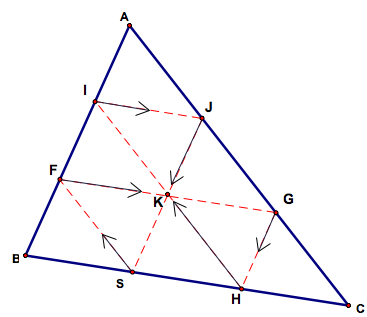
We will prove that triangle ABC is divided into nine congruent triangles when Barney starts at a certain point and that that point is a trisection point.
Proof: By construction, SBIJ is a parallelogram. Therefore SB=IJ because opposite sides of a parallelogram are equal. Also by construction, IJCH is a parallelogram, so IJ=HC. Since HC=IJ=SB, then HC=SB. Again by construction, FKHS is a parallelogram, so FK=SH. And once again by construction, IJKF is a parallelogram. So IJ=FK. So SH=FK=IJ=SB. Then SH=BS=HC, so BC is trisected.
All nine triangles are congruent.
Proof: We will begin by proving that triangle BFS is congruent to triangles SKH and HGC. Since FS and KH are parallel by construction and cut by transversal BC, then angle FSB=KHS. Also, since SK and BF are parallel by construction and cut by BC, then angle FBS=KSH. And since BS=SH, then triangle BFS is congruent to triangle SKH by Angle-Side-Angle congruency. The same argument proves triangle HGC is congruent also.
Now we will show that triangle HGC is congruent to triangles KJG and IAJ. Since KG and BC are parallel lines by construction cut by AC, then angle GCH=JGK. Also since JK and GH are parallel by construction and cut by AC, then angle HGC=KJG. From above CG=JG. So by angle-side-angle congruency, triangle HGC is congruent to triangle KJG. And the same argument can be made to show that triangle IAJ is also congruent.
Now we will show that triangle BFS is congruent to triangle FIK. Since FS is parallel to IK by construction and cut by AB, then angle BFS=FIK. Also since BS is parallel to FK by construction and cut by AB, then angle FBS=IFK. BF=FI, so by Angle-Side-Angle congruency, triangle BFS is congruent to triangle FIK.
Now to prove the remaining three triangles congruent. BFKS is a parallelogram. So FK=BS and BF=SK and they share side FS, so by Side-Side-Side congruence, triangle BFS is congruent to triangle SKF. Also, KGCH is a parallelogram. Thus KG=HC and HK=CG and side HG is shared. So by Side-Side-Side congruence, triangle HGC is congruent to triangle GHK. Again, AJKI is a parallelogram. So AI=JK and AJ=IK and IJ is shared. Thus by Side-Side-Side congruency, triangle IAJ is congruent to triangle JKI.
So when Barney begins at a trisection point, the triangle is divided into nine congruent triangles.